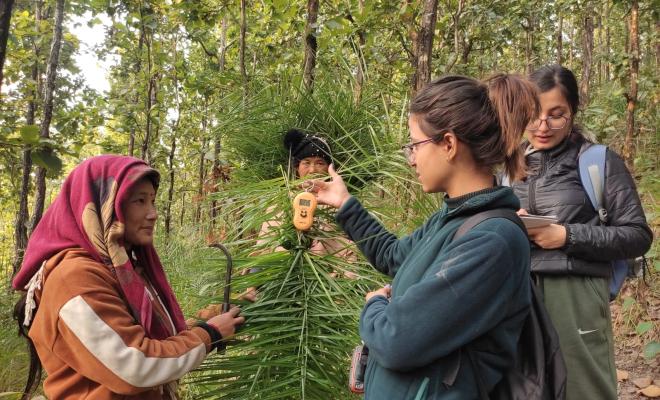Developing gender responsive community forest operational plans for the economic empowerment of women

Community forest operational plans in Nepal must be updated to address the specific needs and interests of women and men. The recommendations given here are crucial for developing gender responsive operational plans that equally empower both genders.
Key messages
- All community forestry operational plans should undergo revision to become gender responsive. This involves addressing the specific needs and interests of both women and men, thereby ensuring equal empowerment for both genders.
- The non-timber forest products (NTFPs) 2012 inventory guidelines should be updated, particularly concerning leaves from the thakal (Phoenix loureiroi Kunth) leaves and sal (Shorea robusta) plants, as they are not clearly mentioned in the guidelines.
- Traditional knowledge from marginalised women and men in forest management is crucial for forest conservation.
Background
Nepal’s Forest Act of 2019 has ensured the right to manage, protect, and utilise designated sections of the national forest through the establishment of Community Forestry User Groups (CFUGs). CFUGs operate as self-governing entities where operational plans are implemented by an executive committee nominated by a general assembly. Membership of executive committees should be 50% women, with women holding two key positions (Forest regulation, 2022).
The major motive for securing female representation in executive committees is to empower women in decision-making processes. However, in Nepal, the prevailing management approach is centred around timber (Baral, 2020). This approach highlights that decision-making is still controlled by men. Additionally, men and women have different roles in managing forests based on their individual needs, interests, and knowledge (FAO 2016).
Women are mostly involved in forestry tasks including collecting firewood, fodder, wild fruit, and non-timber forest products (NFTPs). Men are primarily involved in timber-related activities. Moreover, women's access and rights to forest resources across the country are limited and often overshadowed by men. These gender inequalities have emerged due to gaps in technology, and exclusion from policy-making and decision-making processes (FAO 2016).
Many community forests (CFs) have operational plans that are gender-blind, emphasising only timber management, and designating NTFPs as a general category for all minor forest products. These gaps limit the scope for gender responsive operational plans around specific species, which in the long run negatively impacts the ability of marginalised group to access the most needed minor forest resources for their livelihoods.
This brief illustrates how marginalised women became economically empowered by addressing their specific needs in community forest operational plans. It highlights a process for involving women in formulating Community Forest Operating Plans (CFOPs). Additionally, this brief outlines key recommendations for developing gender responsive operational plans.
Women’s role in developing gender responsive operational plans
When the project 'Economic Empowerment of Women Through Forest Solutions' engaged with marginalised women in Nepal’s Nawalpur district to support entrepreneurial development, the women identified leaves - specifically sal and thakal leaves - as their primary resources on which their livelihoods are dependant. Consequently, the operational plans of four CFUGs - Namuna CFUG, Amarjyoti CFUG, Sandkhadevi CFUG, and Deurali CFUG - were revised.
However, CFOPs were too generic in that they listed NTFPs as an umbrella word for all types of NTFPs. Through consultations with CFUG executives, women entrepreneurs, sub-division forest officials, and the Women’s Economic Empowerment through Forest Solutions project staff, a strategic policy barrier was identified for harvesting larger quantities of these leaves for economic purposes.
Suggestions were received for how to develop a gender responsive sal and thakal harvesting operational plan within the CFOP. This provided an opportunity for integrating strategic gender interests in the plans. Consequently, the project assisted women entrepreneurs in designing NTFP inventories.
Challenges were faced due to the absence of clear provisions in the NTFP inventory guidelines of 2012. A series of stakeholder meetings were convened to address this dilemma, incorporating both traditional knowledge and scientific methods. The forest authorities extended technical support to the women entrepreneurs to conduct scientific inventories of the two leaves. Subsequently, two gender responsive operational plans for Namuna CFUG and Deurali CFUG were approved by the Divisional Forest Office in Nawalpur, and others are in the process of approval.
Currently, women are engaging in periodic harvesting of raw materials for their enterprises, ensuring sustainable forest management. This has resulted in direct employment for 37 individuals and indirect employment for 110 individuals. Alongside economic empowerment, their access and control over resources have increased, their technical knowledge of sustainable forest management has improved, and there has been a positive shift in their attitudes towards forest conservation and preservation.
Moving forward:
The following recommendations are crucial for developing gender responsive operational plans that equally empower both genders:
- Involve marginalised women and men in the CFOP formulation process, particularly at the inventory phase.
- CFOPs should address specific forest resources based on the needs of marginalised women and men.
- Capacity building and regular training on practical forest science for marginalised communities is essential to enhance their capabilities.
- Integrating traditional knowledge into the CFOP formulation processes is vital for sustainable forest management.
- The NTFP inventory guidelines from 2012 need revision to effectively inform the inventory process for each NTFP.

